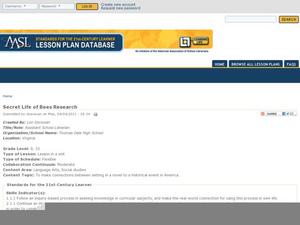Physics Classroom
As the Crow Flies Lab
A simple, yet memorable, way of practicing with displacement vectors is described here. Divide your class into groups and assign each a different landmark on campus. They measure smaller legs of the path from the classroom to their...
Curated OER
Mapping an Empire
How did the expansion of the Roman Empire during the first century contribute to its downfall? Using a map of the Roman Empire in 44 BC and one of the Roman Empire in 116 AD as references, class member use critical reading skills to...
Curated OER
Marching to the Beat of a Different Drum
Henry David Thoreau and Linda Ronstadt? Ann Tyler and Pete Townshend? Joyce Carol Oates and Pearl Jam? This richly detailed plan pairs classic literature with contemporary music and asks learners to analyze how the theme of conformity is...
Curated OER
A Togolese Tale: The Big Fire
Students identify common elements found in folk tales and read a Togolese folk tale told by Fred Koehler. They analyze the folk tale for its elements and compare and contrast it with well-known Western folk tales.
PBS
Stories of Painkiller Addiction: The Cycle of Addiction
Drug addiction, including prescription drug addiction, begins with a reason that's different for every user. High schoolers learn more about the reasons people begin abusing drugs with a set of videos and worksheets that discuss four...
Curated OER
When Court Cases Get Appealed
High schoolers read and analyze two functional documents. They predict outcomes using prior knowledge and documents. Students draw conclusions about how court cases are appealed. They list the parts of a court case.
Curated OER
Presidents
Students identify the qualities needed to become President of the United States. Using the internet, they discover the differences in character of past presidents and draw conclusions about their time in office. They relate a piece of...
Curated OER
Sediment Deposition Lab
Learners set up a stream table, observe erosion, and record data on where various sizes of sediments settle. They draw conclusions as to what kind of sedimentary rock form in what locations.
Curated OER
Ban That Book!
Take advantage of Banned Book Week to pique students' interest and get them reading! Create a classroom display of previously banned books and allow each member of your class to choose one to read. After they have read their book, get...
Curated OER
Heartsongs Poetry by Mattie Stepanek
Use Mattie Stepanek’s Heartsongs book of poetry to inspire young poets to write about their own lives, experiences, and feelings. After reading the introduction to Mattie’s book, in which he talks about himself and his reasons for...
Curated OER
Paraphrasing and Summarizing
Read an article about the migration of our ancestors and write a paragraph. Pupils paraphrase and summarize to restate the information found in a nonfiction text. They write a shortened version of the reading to demonstrate the...
Curated OER
Obstacles to Success: Misleading Data
Eleventh graders explore how data reported by country agencies can mislead the public intentionally or unintentionally. For this Cross Curricular activity, 11th graders analyze charts and graphs in order to draw conclusions. Students...
Curated OER
Science Lab Skills
Young scholars develop problem solving, decision-making and inquiry skills by planning experiments. They conduct systematic observations, interpret and analyze data and draw conclusions then communicate their results.
Curated OER
"Homecoming" by Cynthia Voigt
Students estimate the costs related to the character's expenses in the novel, Homecoming. They draw conclusions based on the estimations.
Curated OER
Macbeth
High schoolers examine patterns of imagery in Macbeth by using online resources. Students compare the patterns they see to those they've found in other Shakespeare plays. Then high schoolers draw conclusions about why Shakespeare might...
Curated OER
A Midsummer Night's Dream
High schoolers examine patterns of imagery in A Midsummer Night's Dream by using online resources. Students compare the patterns they see to those they've found in other Shakespeare plays. Then high schoolers draw conclusions about why...
Curated OER
Othello
Students examine patterns of imagery in Othello by using online resources. Students compare the patterns they see to those they've found in other Shakespeare plays. Then students draw conclusions about why Shakespeare might have used the...
Curated OER
Merchant of Venice
Students examine patterns of imagery in Merchant of Venice by using online resources. Students compare the patterns they see to those they've found in other Shakespeare plays. Then students draw conclusions about why Shakespeare might...
Curated OER
One Plus One Makes New
Students discover the properties of matter and how they change when composite materials are produced. For this informative lesson students write up a question and procedure to an experiment then analyze and draw conclusions based...
Curated OER
Discovering Language Arts-Intermediate Fiction
Explore the elements of science fiction. Young scholars investigate the literary elements present in science fiction and write their own science fiction stories.
Curated OER
Sustainable Agriculture
Students explore examples of methods utilized in traditional agricultural practices. They state examples ot methods used in sustainable agricultural practices. They draw conclusions from information presented to them.
Curated OER
Secret Life of Bees Research
The Secret Life of Bees provides high schoolers an opportunity to connect the events in the novel to events in America’s history. After choosing a topic from a provided list, individuals research how the event affected the Civil Rights...
Curated OER
Primary Sources and Protagonists: A Native American Literature Unit
Introduce your middle schoolers to the lives of past Native Americans. First, learners work together to put photographs in a sequence. Then, using their sequence, they create stories to share with the whole class. No matter how old your...
Curated OER
Sink or Float?
Students investigate whether different objects sink or float in water using the Scientific Method. They listen to the book "Christopher Columbus" by Stephen Krensky, identify the steps of the Scientific Method, conduct the sink or float...























